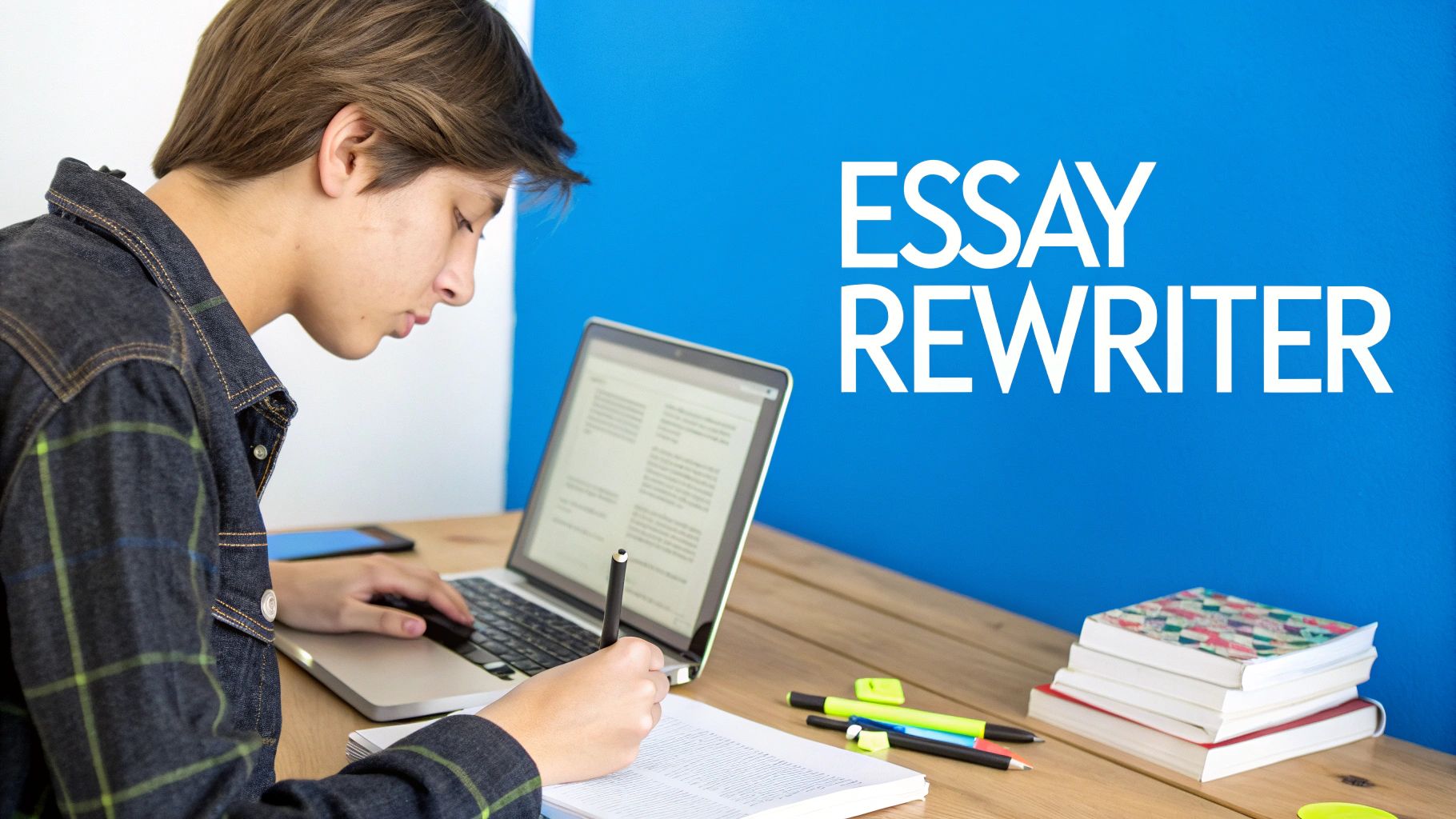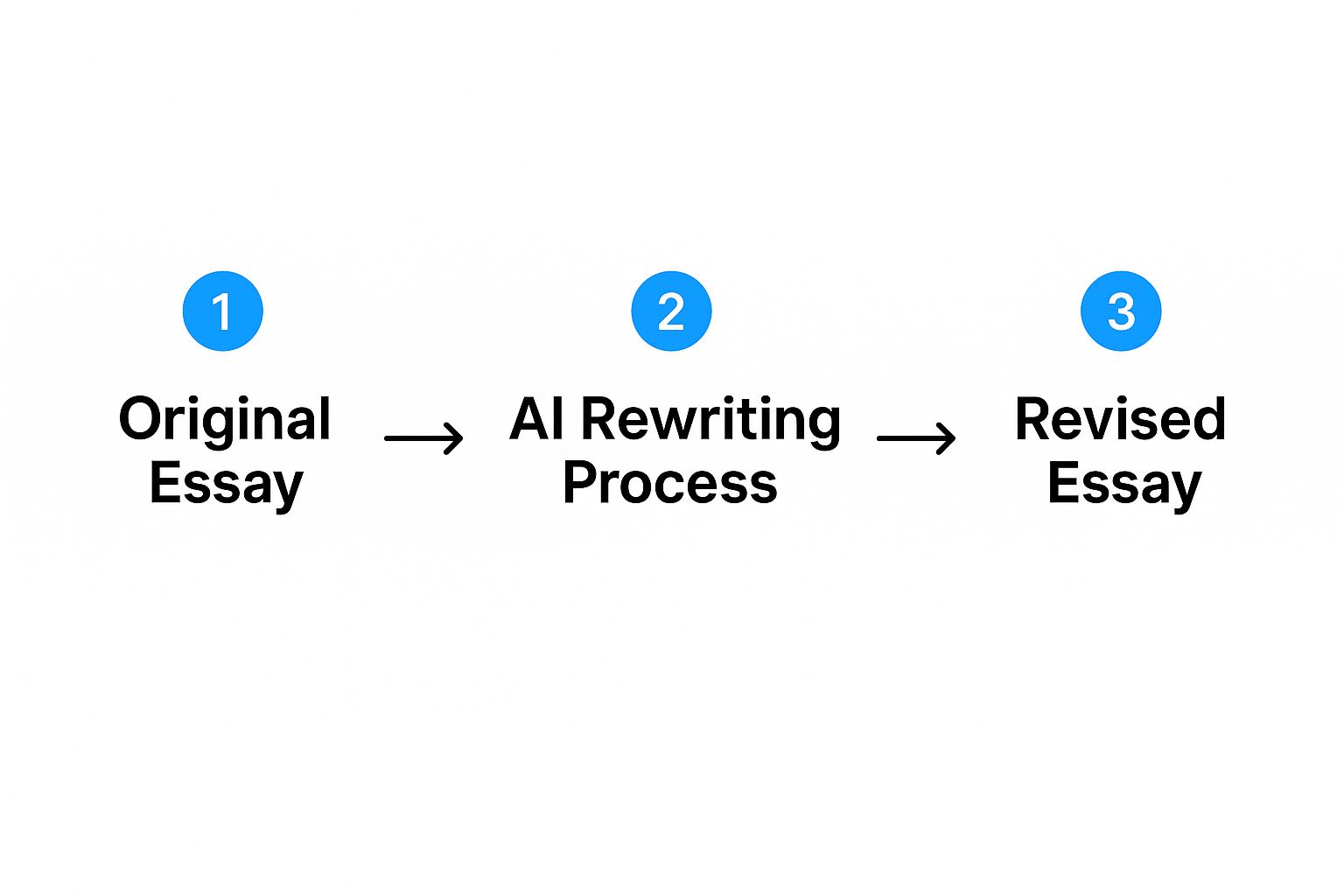Your Guide to a ChatGPT Essay Rewriter

Think of a ChatGPT essay rewriter as a fresh pair of eyes on your paper. It’s a smart way to rework your sentences for better flow, find stronger words, and break through that dreaded writer's block. Basically, you give it your original text, and it gives you new ways to say the same thing, making your writing clearer and more interesting.
Why Use a ChatGPT Rewriter for Your Essays
We’ve all been there—staring at a paper that just doesn't feel right. The ideas are solid, but the phrasing is clunky, repetitive, or just… flat. This is exactly where a ChatGPT essay rewriter can become a very helpful writing partner.
It's not about having a machine write for you. Instead, think of it as a helpful assistant that helps you see your own work from a different angle.
Overcome Creative Hurdles
Sometimes writer's block isn't about having no ideas, but about not finding the right words to say them. A rewriter can get you unstuck by suggesting different sentence structures and words, breathing new life into a paragraph that’s gone stale. This is just one of the many reasons to consider what ChatGPT is good for in a school setting.
This kind of tool isn't brand new, but it’s easier to use than ever. After ChatGPT launched, its use grew quickly. By January 2023—just two months after its release—it had gathered over 100 million monthly active users, making it the fastest-growing consumer app in history at the time.
Strengthen and Clarify Your Arguments
A strong essay is built on clear, convincing arguments. A rewriter is a great tool for sharpening your points by helping you:
- Untangle Complex Sentences: It can break down those long, winding sentences into shorter, more direct statements.
- Improve Word Choice: Get suggestions for synonyms and alternative phrasing to make your language more precise and powerful.
- Maintain a Consistent Tone: It can help smooth out your writing to make sure it keeps a steady academic voice from start to finish.
The goal here is to improve your original thoughts, not replace them. You're polishing your paper until it perfectly communicates your message, making your own voice stronger, not silencing it.
How to Write Prompts for Better Rewrites
Getting a genuinely useful rewrite from ChatGPT isn't about just telling it to "rephrase this." If you do that, you'll get a bland, robotic response that misses the point entirely. The secret is in the instructions you provide.
Think of it like this: you're the director, and ChatGPT is your actor. A vague command will get you a generic performance. But give it specific direction, and you'll get exactly what you need. Instead of a simple "rewrite this," try something much more pointed, like, "Rewrite this paragraph with a more formal, academic voice, but make sure the core argument about economic impacts stays front and center."
The better your prompt, the better the result. It’s that simple.
This is the basic flow you'll follow, moving from your initial paper to a much stronger final version using a good AI rewriter.
As you can see, that middle step—the actual rewriting—is where your instructions make all the difference. It's what guides the tool to create something truly improved.
Putting Prompts Into Practice
To get the results you're after, you have to be precise. Don't be afraid to give the tool several constraints in a single command. The trick is to break down exactly what you need.
Here are a few real-world examples to get you started:
- For Tone: "Adjust this section to sound more persuasive. I'm writing for a skeptical audience."
- For Clarity: "Simplify these complex sentences so they're easier to read, but don't lose any of the technical meaning."
- For Expansion: "Expand on this point about cellular mitosis. Can you add a simple analogy to help explain the process?"
Mastering this skill takes a bit of practice. It helps to see how others are crafting effective ChatGPT prompts for different tasks, as many of the same principles apply here. Learning how do I ask ChatGPT to polish my writing is all about experimentation.
Prompt Examples and Their Rewriting Outcomes
To really see the power of specific instructions, look at how different prompts can completely change the same piece of original text. It’s a night-and-day difference.
| Original Text | Prompt Used | Rewritten Output |
|---|---|---|
| The study found that the thing had a big effect. | "Rewrite this sentence using formal, academic language." | The research concluded that the variable had a significant impact on the outcome. |
| Because of the rain, the game was canceled. It made everyone sad. | "Combine these sentences and adopt a more descriptive, narrative tone." | The relentless downpour led to the game's cancellation, casting a pall of disappointment over the crowd. |
As you can see, a well-written prompt gives you control, allowing you to steer the tool toward a final product that meets your exact standards for tone, readability, and style.
Reviewing and Improving the AI-Generated Text
Here’s where so many people go wrong: they treat the output from a chatgpt essay rewriter as the final version. Don't make that mistake. What the tool gives you is a really solid starting point, but it's far from a finished product. Your critical eye is what will turn a decent AI rewrite into an excellent essay that actually sounds like you.
Your first read-through should be all about the big picture. Does the essay still argue what you wanted it to? It’s surprisingly easy for a tool to subtly shift the focus or weaken your main points while it’s busy rephrasing everything. Make sure your original thesis is still front and center and that the logical flow supports it from start to finish.
The Human Touch Checklist
Once you're confident the core structure is solid, it's time to get into the details. This is where you really add the value. As you dig into the text, keep a few key questions in mind:
- Is it factually correct? AI tools are known for making up "facts" or just getting things wrong. You need to double-check every date, name, and important piece of information against a reliable source.
- Does it sound like a person wrote it? Be on the lookout for awkward phrases or sentences that feel a little too stuffy and robotic. A great trick is to read it out loud—your ears will catch any clunky rhythms your eyes might miss.
- Is the tone right? The tone needs to fit the assignment. Whether you’re aiming for persuasive, analytical, or purely informative, make sure the language is consistent throughout.
Think of yourself as working with the tool, not just taking its output. By actively shaping and improving the text, you're taking back ownership of the work and making sure it meets high academic standards. For more great tips, check out our detailed guide on how to edit AI-generated content for a human touch.
For that final layer of polish, a specialized tool can be a great help. Many writers are turning to platforms like Word Spinner to iron out any leftover AI stiffness. Its advanced rewriting makes the text flow more naturally, helps it pass AI detectors, and guarantees 100% plagiarism-free output.
This approach is becoming common in a market that's growing quickly. The industry for AI text tools is on track to jump from a few hundred million dollars in 2023 to over $1.3 billion by 2025. You can see more of these exploding AI statistics on Exploding Topics if you're curious.
How to Avoid Plagiarism and Keep Your Voice
Using a chatgpt essay rewriter the right way is the most important part of this whole process. Let’s be real—the biggest fear for any student is accidentally crossing the line from getting a little help to academic dishonesty.
The secret is to think of the AI as a smart assistant that helps improve your ideas, not a machine that comes up with them from scratch.
This means you should never just copy and paste what the AI gives you. Instead, work on your essay in small, manageable chunks. Feed it one paragraph at a time, let the AI rephrase it, and then immediately compare that version with your original thoughts. This simple back-and-forth keeps you in control and makes sure your unique perspective doesn’t get lost.
Maintaining Your Unique Perspective
The absolute best way to keep your work original is to put your own analysis into every part of it. After the AI rewrites a section, you need to stop and ask yourself a few questions:
- Does this still sound like me?
- Can I add a personal thought or a specific example right here?
- Is my main argument still front and center?
This manual check-in is a must. It's the one thing that separates responsible use from straight-up plagiarism. It's also smart to understand the current situation with AI detection. Knowing whether AI-generated text can be detected helps you see why making the final text truly yours is so important.
Your voice is your most powerful asset as a writer. The goal here is to amplify that voice by making it clearer and more impactful, not to swap it out for a generic, robotic one.
Using these tools is becoming standard. A recent survey found that a surprising 90% of content marketers now use AI writing tools, with 78% of them leaning on ChatGPT for tasks like drafting and rewriting.
For students who care about integrity, the right tool makes all the difference. For instance, a platform like Word Spinner is built to humanize content. It helps you keep a natural tone and produce work that is guaranteed to be 100% free from plagiarism.
To get more comfortable with these ideas, check out our guide on how to use AI without plagiarizing so you can feel completely confident when you hit "submit."
Common Rewriting Mistakes and How to Fix Them
It’s tempting to treat a chatgpt essay rewriter like a magic button, but that’s where the trouble starts. The biggest mistake I see people make is just accepting the first version ChatGPT gives them without a second thought. This almost always leads to text that sounds generic and completely strips away the unique thoughts that make an essay stand out.
Another common pitfall is losing the fine points of your argument. In its effort to "improve" your writing, an AI can smooth out the language so much that it accidentally waters down your main point. You might end up with something that’s grammatically flawless but has lost the entire spirit of your original work.
Fixing a Generic Tone
If your rewritten essay feels flat and impersonal, the problem usually isn't the tool—it's the prompt. Ditch the simple "rewrite this" command. You need to give the AI more context to work with.
Try layering your instructions with details about your audience and goal:
- "Rewrite this for a first-year college course, keeping the tone academic but easy to follow."
- "Rephrase this section to sound more persuasive, as if I'm trying to convince a skeptical reader."
Giving the AI this extra direction is the key to getting a version that actually helps you, saving a ton of editing time down the line.
Remember, the point of a rewrite is to improve your existing work, not to erase your voice from it. Each edit should bring the essay closer to your intended message, making it clearer and more impactful.
Preserving Your Core Argument
To keep your main points from getting lost, you have to work in smaller pieces. Don't just paste your entire essay into the tool at once. Go paragraph by paragraph.
After each rewrite, pause and compare the new text to your original. Ask yourself, "Does this still make the same point?" This careful approach makes sure you stay in control, keeping your core ideas strong and clear from start to finish. It’s a simple check, but it’s very effective at maintaining your argument's integrity.
Common Questions Answered
Let's tackle a couple of the big questions that always come up when people start using ChatGPT to help with their essays. Getting clear on the practical and ethical sides of things is key to using these tools the right way.
Can Teachers Tell If I Used A ChatGPT Essay Rewriter?
AI detectors are out there, but let's be honest—they're not perfect. The smartest way to use a rewriter is to think of it as an assistant, not a ghostwriter.
When you take the AI's suggestions, then review, personalize, and tweak the text to match your own voice and understanding, the work is truly yours. The whole point is to improve your existing draft, not to have AI create the essay from scratch.
Is Using a Rewriter Considered Cheating?
This really comes down to your school's academic integrity policy. If you're just plugging in someone else's work to rephrase it, that's classic plagiarism. No gray area there.
But if you're using it to sharpen the grammar and clarity of your own original thoughts, it’s often seen in the same way as using a thesaurus or a grammar checker. Still, you should always double-check your school's specific rules to be safe.
The goal is to use the tool to improve your own ideas, not to create them. To stay on the right side of academic honesty, the final essay has to reflect your personal analysis and grasp of the subject.
To get your final essay looking polished, natural, and completely original, check out Word Spinner. Our platform is built specifically to humanize AI-generated text, helping you produce high-quality work that can confidently get past detection software. Give it a try today at https://word-spinner.com.



